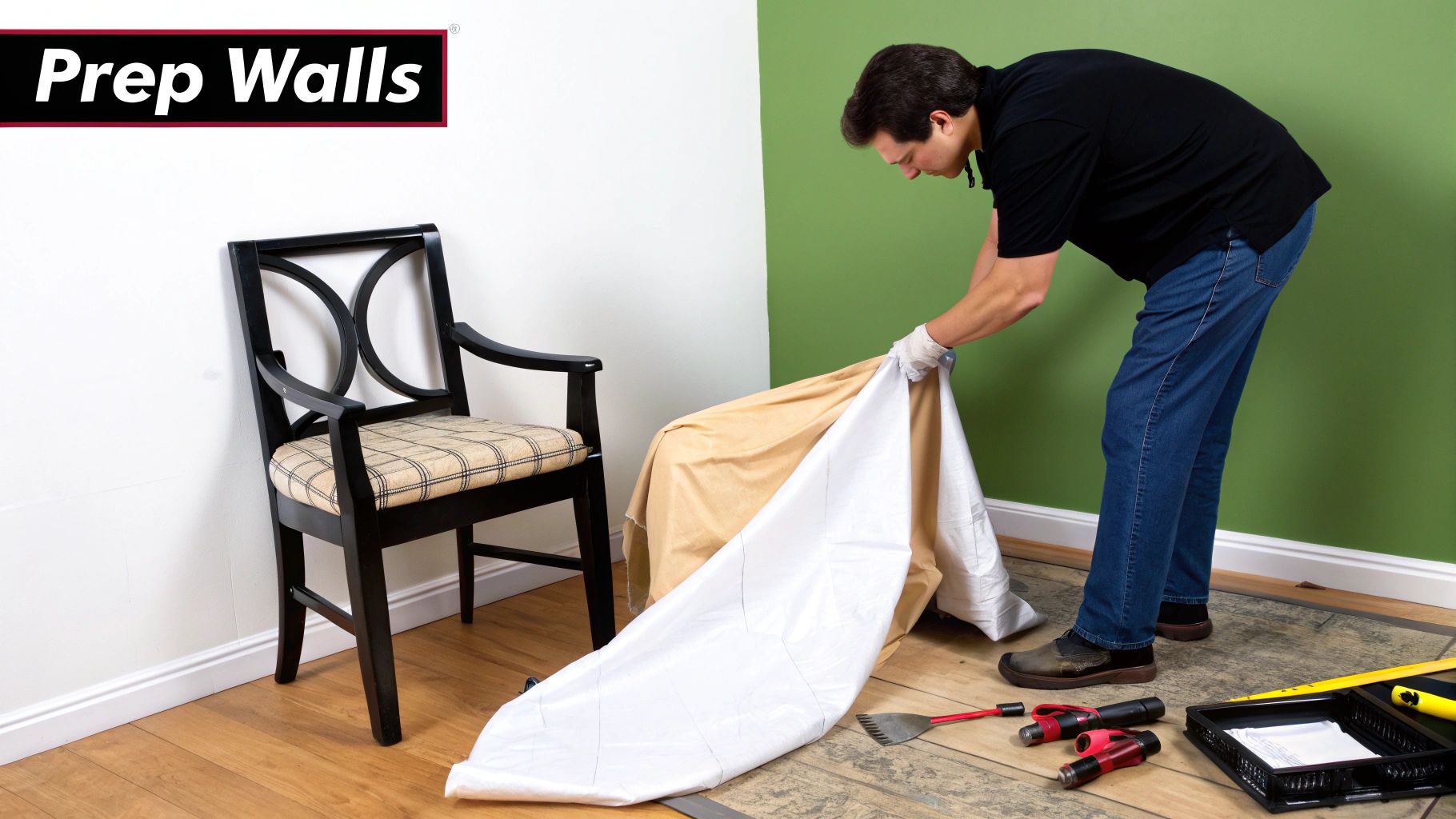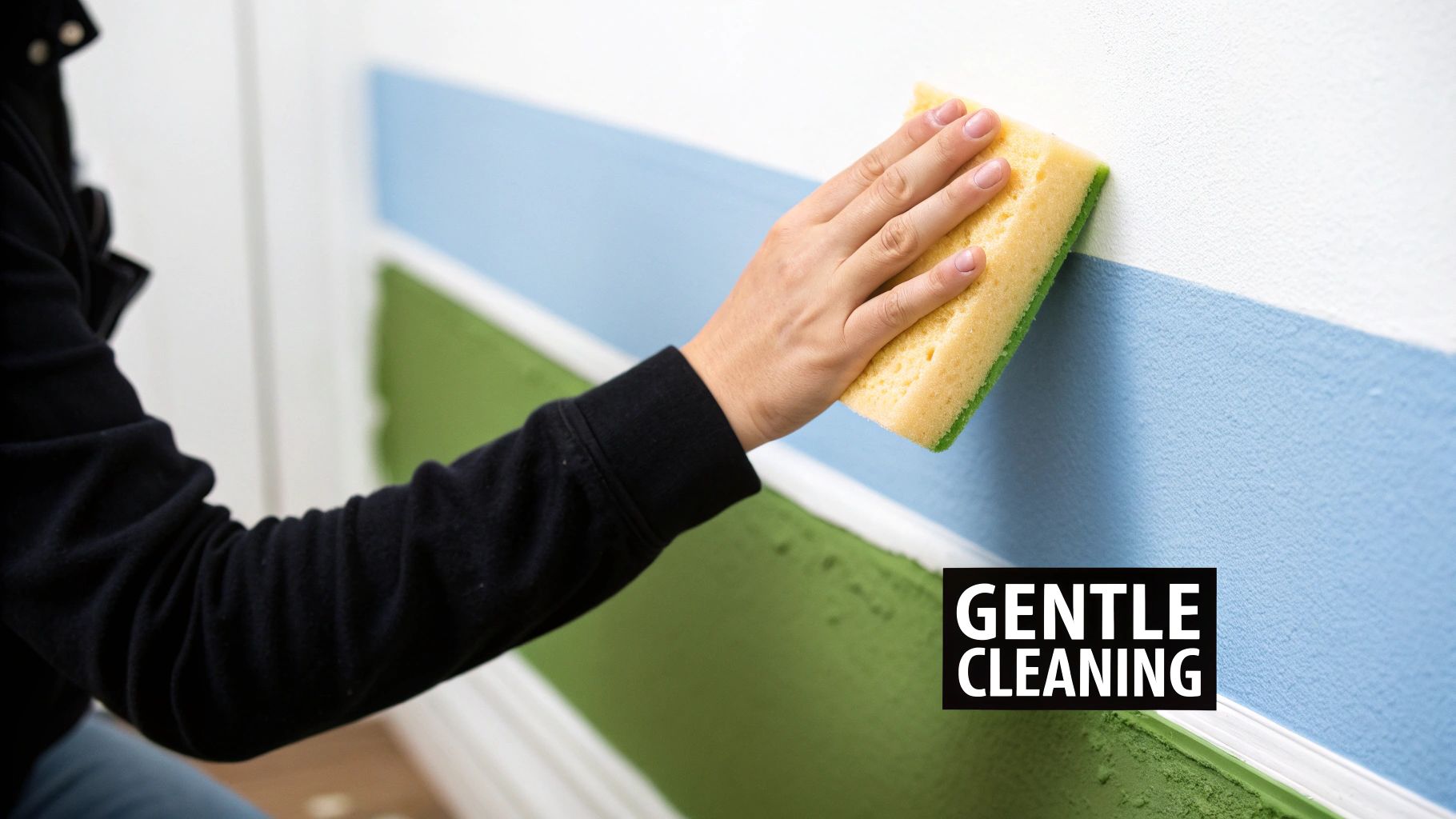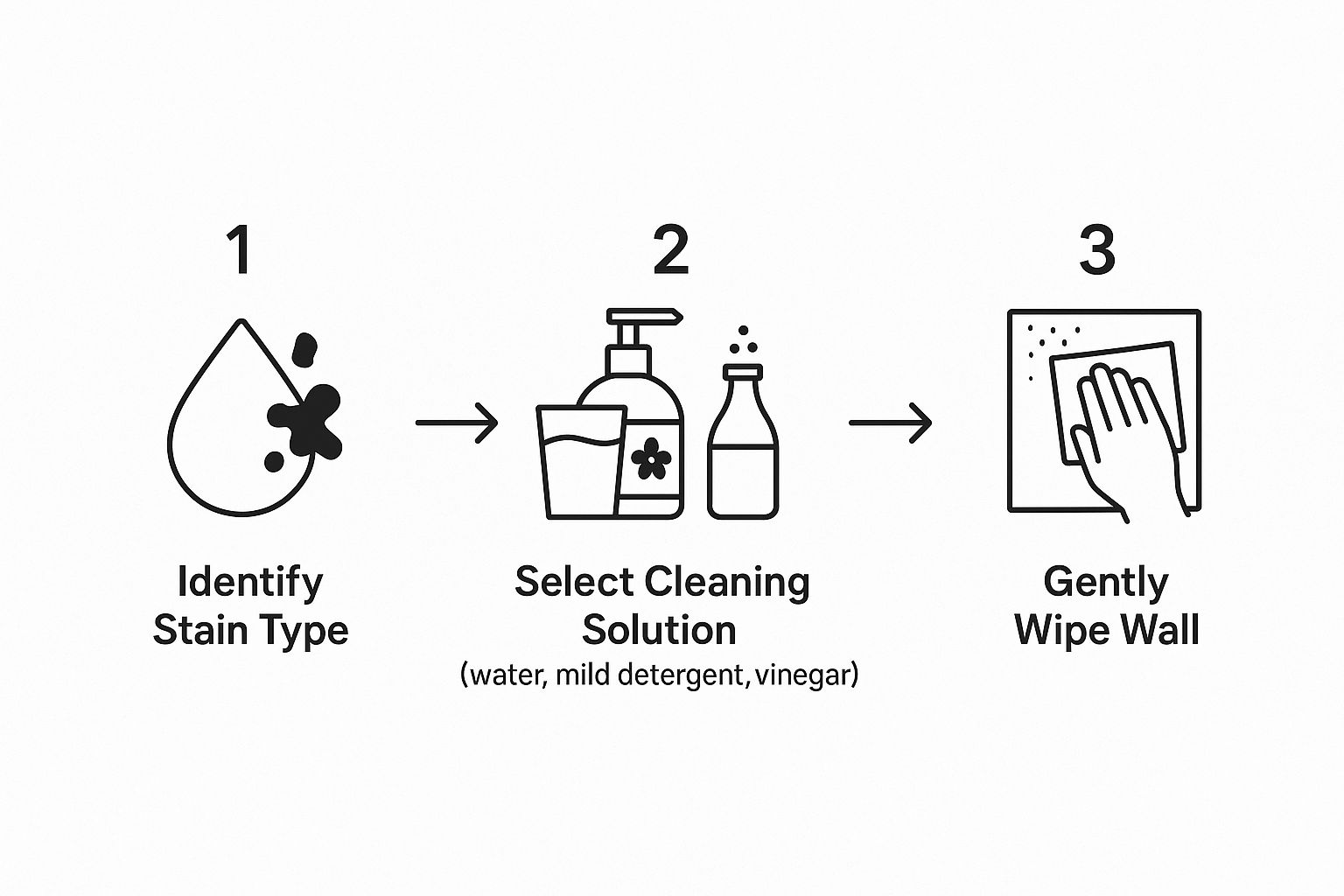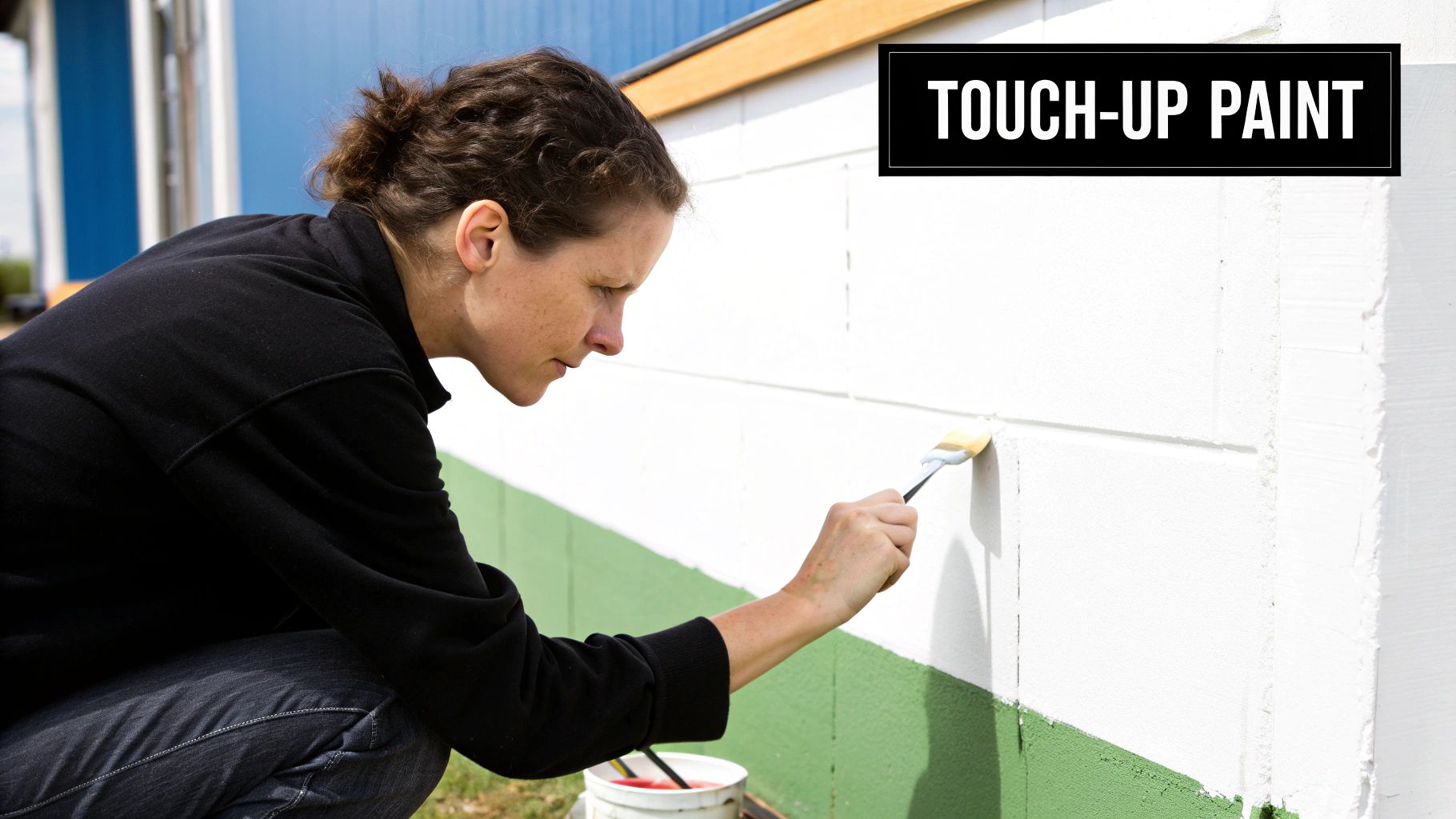Cleaning walls with flat paint is a delicate dance. You need a gentle touch because its beautiful, matte finish is porous and notoriously easy to damage. The secret isn't some magic product—it's using the mildest solution possible and blotting stains, never scrubbing. One wrong move with an aggressive cleaner, and you can permanently ruin that velvety finish.
Why Cleaning Flat Paint Is So Tricky
That gorgeous, velvety look of flat paint is fantastic for hiding small imperfections on your walls. But as you've probably figured out, that soft texture comes with a major downside: it’s incredibly challenging to clean without leaving a mark. And it's not you—it's the paint itself.
Unlike its glossy cousins which have a tough, sealed surface, flat paint has a porous texture. Picture it less like a protective shield and more like a tiny sponge. This unique structure is what kills reflections and gives it that sophisticated matte look, but it also means the paint particles are spread out, leaving microscopic gaps all over the surface.
The Science of a Stubborn Stain
When something like dirt, oily fingerprints, or a splash of coffee hits the wall, it doesn't just sit on top. It sinks right into those tiny pores, embedding itself deep within the paint layer. This is exactly why a quick wipe-down often just smudges the mess or leaves a faint shadow behind.
This porous nature also leads to another common headache: burnishing. When you scrub a flat-painted wall, you're not just wiping away a stain; you're physically mashing down the paint's texture. The friction from your sponge or cloth flattens those microscopic peaks and valleys, creating a shiny, dark-looking patch that catches the light differently from the rest of the wall.
Key Takeaway: Burnishing is permanent. Once you've created that shiny spot, there's no washing it away. The only real fix is to touch up the area with fresh paint, which is why starting with a gentle, patient approach is non-negotiable.
Homeowners and professional services alike struggle with this; flat paint is just less durable against scrubbing than glossier options. You can find out more about current interior paint market trends and challenges to see just how common this issue is. Understanding this from the get-go changes your whole strategy from aggressive scrubbing to a more careful mission of lifting the stain out of the paint's surface.
Before you grab a sponge, it helps to have a clear game plan. Knowing the right and wrong moves can save you from a frustrating afternoon of making things worse.
Your Cheat Sheet for Cleaning Flat Paint
This quick table breaks down the core principles for safely cleaning matte-finish walls. Think of it as your go-to guide to avoid common mistakes.
| Do This (The Gentle Approach) | Avoid This (The Damaging Approach) |
|---|---|
| Blot or Dab Gently: Use a soft sponge or cloth to press lightly on the stain. | Scrub or Rub Hard: This creates friction and leads to permanent burnishing (shiny spots). |
| Start with Water: Always try the mildest option first—a clean, damp cloth. | Use Harsh Chemicals: Bleach, ammonia, or abrasive cleaners will strip the paint. |
| Use a Microfiber Cloth: It's soft and effective at lifting dirt without damaging the surface. | Use Abrasive Sponges: Magic erasers or the scrubby side of a kitchen sponge are too rough. |
| Work from the Outside In: For larger stains, clean toward the center to prevent spreading. | Apply Cleaner Directly to the Wall: This can cause drips and uneven saturation. Apply to your cloth first. |
| Test in a Hidden Spot: Always try your cleaning solution on an inconspicuous area first. | Soak the Wall: Too much water can weaken the paint and cause it to peel or bubble. |
Remember, patience is your best friend here. A slow, gentle approach will always give you better results than trying to power through a stain.
Gathering Your Supplies for a Gentle Clean

The secret to cleaning walls with flat paint isn't a miracle product—it's all in the toolkit. Having the right supplies ready before you even touch the wall is what separates a successful touch-up from a costly mistake. This is really about choosing gentle, non-abrasive tools that won't betray that delicate matte finish.
Your Essential Cleaning Kit
Before you start scrubbing, you need to dust. For this, a soft microfiber cloth or a duster on an extendable handle is non-negotiable. These grab onto dust and cobwebs without grinding them into the paint.
Once you're ready for the actual cleaning, here’s what you’ll need:
- Natural Cellulose Sponges: Steer clear of those green-and-yellow kitchen scrubbers. A soft, natural sponge is perfect because it holds just enough of your cleaning solution without being too harsh.
- Two Buckets: This is a pro tip you shouldn't skip. One bucket is for your mild cleaning mix, the other for clean rinse water. Keeping them separate is key to not just smearing dirty water back onto the wall.
- Clean White Cloths: Using white cloths might seem overly cautious, but it prevents any potential color bleed from the fabric onto your light-colored paint. It’s a surprisingly common problem!
This simple setup is your foundation for getting the job done right. For more professional strategies that go beyond just walls, take a look at our guide on how to clean your house like a pro.
Crucial Tip: Always, and I mean always, test your cleaning solution on a small, hidden area first. Think behind the couch or inside a closet. Let it dry completely to make sure it doesn't leave a mark or damage the paint. This five-minute test can save you from the headache of repainting an entire wall.
Thoughtful preparation like this is your best defense against damaging matte walls. When you start with the right tools, you've already won half the battle.
Choosing the Mildest Cleaning Solutions

When you're cleaning flat paint, the golden rule is to start gentle. You can always get more aggressive if you need to, but you can't undo damage from a harsh chemical. Aggressive cleaners are the quickest way to ruin that delicate matte finish, so your first move should always be the simplest one.
Believe it or not, plain old water is often all it takes. For fresh scuffs, light smudges, or dusty fingerprints, a soft sponge or microfiber cloth dampened with clean water can work wonders. The real trick is to wring the sponge out until it’s barely damp. You want to avoid over-saturating the wall at all costs.
Creating a Gentle Soap Solution
If water alone doesn't do the trick, it's time to step it up just a notch with a simple soap solution. This is not the time for heavy-duty degreasers or all-purpose sprays. Instead, you'll mix a gentle, effective cleaner yourself.
- Start with warm water in a clean bucket.
- Add just a few drops of a mild, clear dish soap. You’ll want to avoid anything with bleach, heavy dyes, or intense degreasing agents.
- Gently swish the water to create light suds—you’re not aiming for a mountain of foam here.
This simple mix is surprisingly good at breaking down everyday grime and oils without being harsh enough to strip the paint. It’s a method that aligns with the growing trend toward natural cleaning—nearly 46% of consumers now lean toward eco-friendly options to avoid harsh chemicals. If you're curious about picking the right products, our guide on how to choose cleaning products has some great tips.
Using Abrasives with Extreme Caution
For those stubborn scuffs that soap and water won’t touch, you might be tempted to reach for something with a bit more grit. This is where you have to be extremely careful.
Expert Insight: Think of a melamine foam sponge (like a "magic eraser") as your absolute last resort. It works by acting as an incredibly fine sandpaper, which means it’s literally removing a microscopic layer of your paint.
If you absolutely must use one, dampen it with water and apply the lightest pressure imaginable, rubbing in a soft, circular motion. Never use it for general cleaning; it's for targeted scuffs only. A homemade paste of baking soda and water can work similarly, but it carries the same risk of burnishing or polishing the paint if you scrub too hard.
Always, always test these abrasive methods in a hidden spot first. Behind the sofa or in a closet is a perfect place.
Mastering the Right Cleaning Technique
When it comes to flat paint, your cleaning method is just as important as the solution you're using. The wrong move can instantly leave behind a shiny, burnished spot that looks even worse than the original stain. You'll need to forget everything you know about scrubbing and embrace a much, much gentler approach.
For fresh spills or smudges, the idea is to lift the stain away, not grind it deeper into the wall. This is where the "blot and lift" method is your best friend. Take a clean, barely damp sponge, press it gently against the mark for a few seconds, and then lift it straight off. Absolutely no wiping or rubbing—that friction is what damages the paint’s delicate texture.
If you're dealing with a more stubborn, set-in scuff, try the "dab and roll" technique. Lightly dab the spot with your damp sponge, then gently roll the edge of the sponge over the area. This subtle motion is surprisingly effective at dislodging dirt without the harshness of a back-and-forth scrub.
This quick guide gives you a visual for tackling any mark on your flat paint wall.

As the infographic shows, a great result always starts with knowing what kind of stain you have before you pick a solution and start gently wiping.
Executing the Perfect Clean
Always work in small, manageable sections—think one or two square feet at a time. This keeps your cleaning solution from drying on the wall, which is the number one cause of streaks and watermarks.
Crucial Last Steps: After the stain is gone, immediately grab a new, clean cloth dampened with only fresh water. Gently blot the area to rinse away any leftover soap residue. Finally, pat the spot completely dry with a third cloth to stop water spots from forming.
While cleaning flat paint has its unique challenges, some core principles—like mastering your technique to avoid marks—are universal. For instance, you can explore tips on professional cleaning techniques for a streak-free shine that apply to all sorts of household tasks. Trust me, these final rinsing and drying steps are non-negotiable if you want a flawless finish.
Tackling Tough Stains on Flat Paint

Sometimes, even with the most careful technique, you’ll run into a stain that just won’t budge. I'm talking about the usual suspects: grease, crayon, or an accidental ink mark. These tougher messes on a flat finish call for a more focused approach, but you still need to be gentle.
For something like a greasy fingerprint, a 50/50 mix of white vinegar and water often does the trick. The vinegar is great at cutting through oil without the harsh chemicals you'd find in a typical degreaser. Got an ink mark? Try dabbing it lightly with a cotton swab dipped in a tiny bit of rubbing alcohol.
Important Takeaway: Always apply these stronger solutions to your cloth or sponge, never directly onto the wall. This gives you way more control and prevents drips from making things worse.
Knowing When to Stop
The most important skill in cleaning flat paint is knowing when to throw in the towel. Seriously. If you've tried gently treating a stain and it's not disappearing, more scrubbing is your enemy. It's only going to burnish the paint, leaving a shiny, damaged spot that's often more noticeable than the original stain. That’s the point of no return.
Keep an eye out for these tell-tale signs that it’s time to stop:
- You start seeing the paint color coming off on your cloth.
- A faint, shiny patch begins to appear where you’ve been cleaning.
- The stain has faded a bit but is clearly set deep into the paint.
At this point, the best solution is a simple paint touch-up. Making that call early saves you a lot of frustration and prevents damage you can't undo. It's no surprise that the demand for specialized wall cleaning is growing—these delicate surfaces can be a real challenge. You can learn more about the trends in the wall cleaning services market to see what the pros are dealing with. For other stubborn household marks, our guide on how to remove hard water stains might also be a lifesaver.
Common Questions About Cleaning Matte Walls
Even with the best game plan, you might still run into a few tricky situations when cleaning flat paint. Let's walk through some of the most common questions so you can tackle those walls with confidence and keep them looking flawless.
Can I Really Use a Magic Eraser on Flat Paint?
Yes, but you have to be extremely careful. A magic eraser (melamine foam) isn't a sponge—think of it more like ultra-fine sandpaper. If you get too aggressive, you’ll literally sand the finish right off the paint, leaving a shiny, permanent patch called burnishing.
To use one safely, get the eraser just a little damp and use the lightest pressure imaginable. It’s really a last resort for specific, tough scuffs, not for cleaning large areas. Always, always test it first in a spot no one will see, like behind a sofa, to check how your paint holds up.
What Is the Best Way to Remove Greasy Fingerprints?
Ah, the dreaded greasy fingerprints. They’re a pain but definitely removable. The trick is to use something that can cut through the oil without stripping the paint.
- Grab a bowl of warm water and add just a few drops of a gentle, grease-fighting dish soap.
- Dip a soft sponge into the solution and gently dab—don't scrub!—the spot.
- Once the grease is gone, "rinse" the area by dabbing it with a different cloth that's just damp with clean water.
- Pat the area completely dry with another clean, soft cloth to make sure no water spots form.
How Often Should I Clean Flat Paint Walls?
A little proactive maintenance goes a long way. Give your walls a quick dusting every couple of months to keep cobwebs and grime from settling in. When it comes to scuffs and stains, it’s always best to spot-clean them as soon as you see them. Fresh marks are so much easier to get rid of.
Pro Tip: Try to avoid washing an entire wall unless it’s an absolute emergency. That’s just asking for a streaky, uneven finish. A consistent spot-cleaning routine is the safest and most effective way to maintain those beautiful matte walls.
If tackling those walls still feels like too big of a job, the professionals at Custom Maids are here to help. For a home that's consistently clean and beautiful, schedule your free consultation today.

